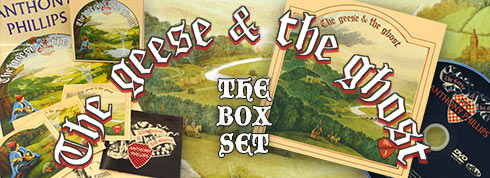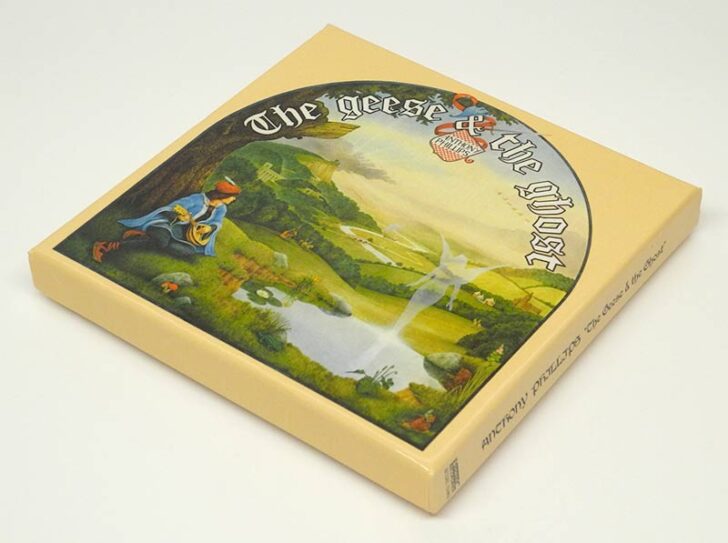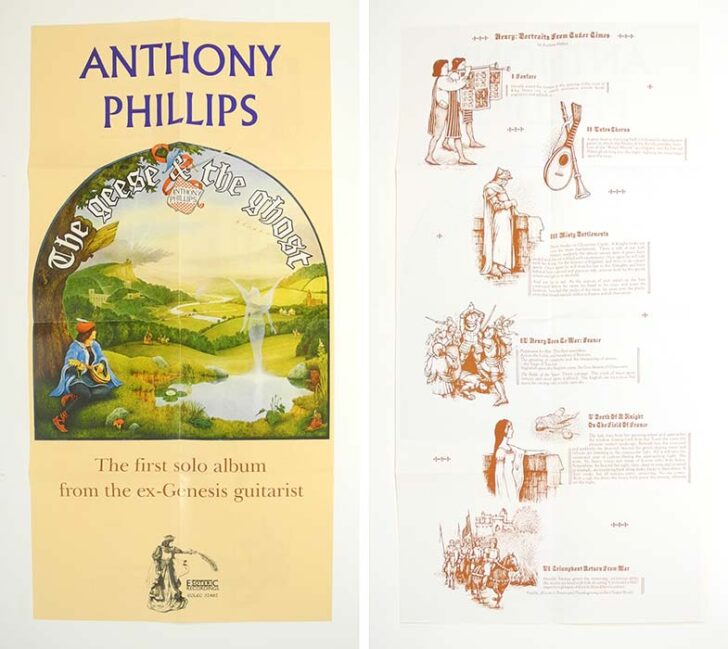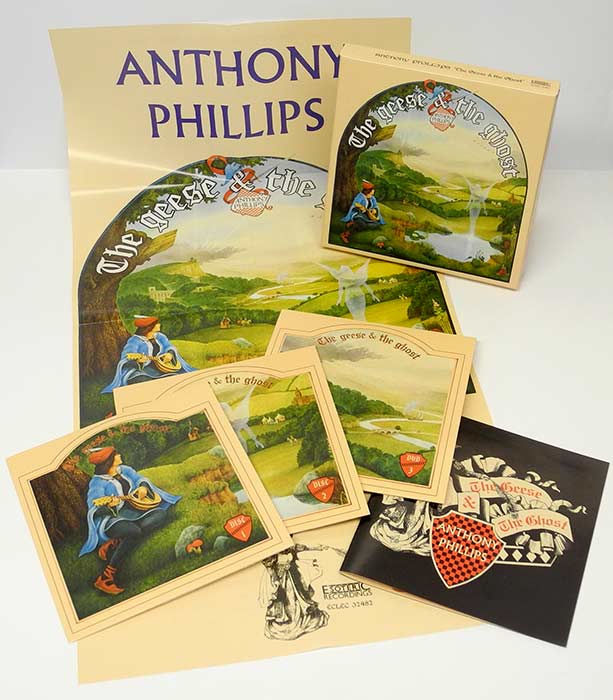- Article
- Read in 8 minutes
Anthony Phillips – The Geese & The Ghost – 5.1 Surround Sound (2CD/DVD review 2015)
After a remaster of his debut album in 2008, Anthony Phillips released another version of the album in 2015. The 2CD/DVD set contains the long lost Only Your Love as well as a brand new 5.1 surround sound mix. Tom Morgenstern has checked it out.
When he was our guest of honour at the fanclub’s “Ant Event” in March 2014, Anthony Phillips mentioned his new label Esoteric were interested in releasing a surround sound mix of Ant’s debut album The Geese & The Ghost. That was a pleasant surprise for most visitors and nothing less than sensational news to others. At that time, Phillips had no idea who would do the remix. He himself did not want to be involved in this. It was clear that he did not relish the idea of going through this laborious task.
It was as if he had known what was coming: In the booklet for the news release he writes that the surround mix proved not as easy to create as one would have expected. Work was hampered by a special property of the original stereo mix: Different instruments had been piled on top of each other in many places to create a particularly rich sound. Distributing them across the five channels could have led to the whole music simply falling apart. We can say right away: That did not happen.
A few words about the package. The album comes in a simple cardboard box (with the mechanics of a pizza box) that fits onto all CD shelves. It has Peter Cross’s familiar artwork on the front, perhaps a bit too dark, but also a big larger than on the Jewel Case booklets of previous issues. The goose in a knight’s armour on the rear is cramped for space because the box with the song titles and the bar code takes up two thirds of the area. The font used for the spine of the box is not really suited for having everything in capital letters; it looks a bit awkward and makes you doubt the designer’s competence.
The box opens like a pizza box, i.e. you fold the lid upwards. That’s a bit unusual because almost all other media packages open like a book. Inside, each of the three discs has its own cardboard sleeve printed with different details of the front artwork. Fortunately they have gone back to the original font for these. The song titles are listed on the rear. The discs do not sit too tightly in their sleeves so there is no risk of scratches when you pull them out.
The booklet basically contains the same information as the booklet of the 2008 remaster, albeit with a new design and different grouping. The front of the booklet shows a new variant of the coat of arms that used to grace Phillips’s first album in various forms. It looks nice, but the quality is not quite up there with the drawings of Peter Cross who designed the original artwork for Anthony Phillips’s first albums.
The box also contains a folded poster. Its front mimics a contemporary newspaper ad for the album. The upper half shows the front artwork in an acceptable size so we can discover all the details Cross hid in there with so much love. The rear shows Cross’s drawings and the explanations for the Henry Suite that were printed on the dust jacket of the original vinyl. Unfortunately, the lyrics for the three songs were not included – they are neither on the poster nor in the booklet. The package is well done all in all, and it lends the appropriate weight to the special status of the album. A larger package would have been even better, but that, of course, is always a matter of budget and numbers produced.
There is not much point in discussing the two CDs here because they are almost identical with the 2008 remaster (our review of that release can be found here). The only difference is a highly welcome one, though: At the end of the bonus disc there is a song that has not been published before called Only Your Love. It is the B-side of the legendary, never released Phil Collins single Silver Song. Recorded in 1973, fans could only find this song on bootlegs in very questionable audio. This amends the biggest flaw of the 2008 edition.
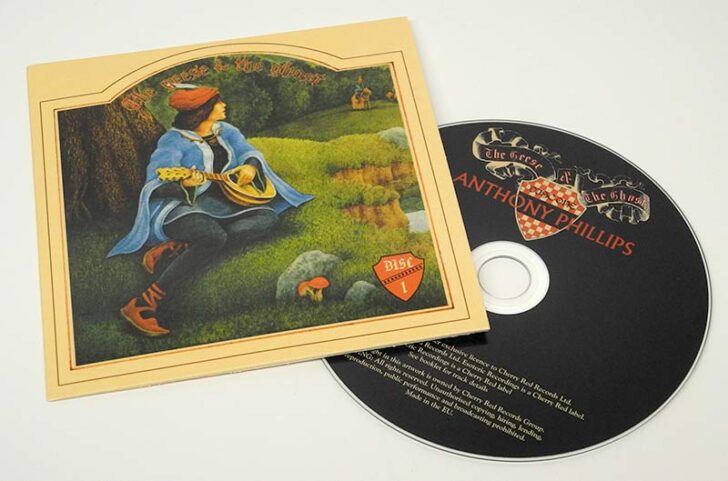
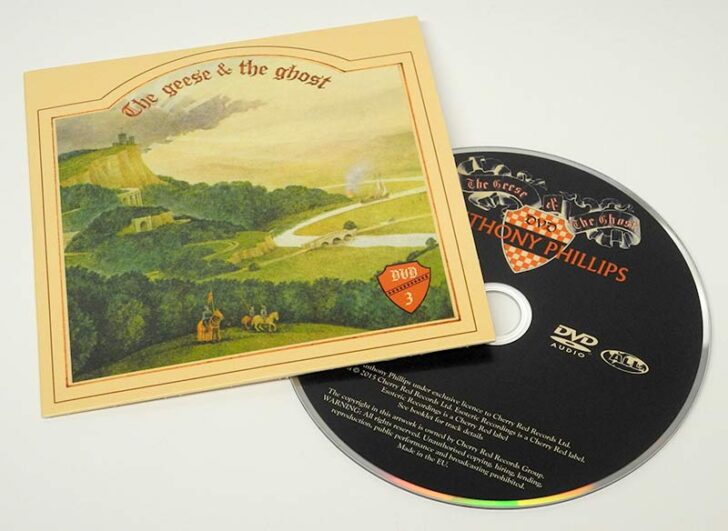
The core of this new edition, though, is the surround mix created by Simon Heyworth on disc 3. Surprisingly it is a real DVD-Audio, a format that has been declared dead for a long time because it was as unsuccessful as the SACD. Both formats have been replaced with the more versatile Blu-ray, though pure audio content in surround sound is frequently put out on “normal” DVDs. Real DVD-Audio discs are quite exotic. Fortunately, downward compatibility was provided so that the surround mix can be played on every DVD player with the usual DTS and Dolby Digital formats. If you want to hear the lossless audio (MLP – 24bit/48kHz) you need a special player that supports the DVD-Audio standard.
Navigation: All menus have a resolution of 720×480 pixels in 16:9; they are simple and to the purpose. When you start the DVD a brief animation comes on: The album cover that almost fills the screen in the beginning, shrinks and moves to the right to make space for the letters of the top menu. The options do not appear very logical here: “Play Surround”, “Play Stereo” and “Audio Select”. If you choose either of the first options the album begins to play right away, while the third option brings you to a submenu (with a close-up of the Ghost) that gives you the choice between five different audio formats:
MLP Lossless 5.1 Surround
MLP Lossless Stereo
DTS 5.1 Surround
Dolby Digital 5.1 Surround
LPCM Stereo
If you choose one of the MLP formats you can jump to the individual parts of the Henry suite and the title song with the skip buttons. Pressing them with the other audio formats takes you forward to the next song or back to the beginning of the present song.
The audio select menu lies, however, for this is not 5.1 surround sound at all! There is a subwoofer channel (the “.1” channel, as it were), but it is empty or rather only filled with digital zeros. This is, admittedly, not unusual with pure audio surround mixed. The audio engineer avoids the tricky question of arbitrarily setting the volume of the LFE channel this way. Movies can live with that, music is usually more sensitive to that, which is why sound engineers frequently opt for 5.0 sound. In my opinion, they ought to be honest and call it that, then.
They also cheated about the variety of sound options: While the formats LPCM Stereo and MLP Lossless Stereo are there they are redundant because they have the exact same lossless PCM signal. Whoever worked on that apparently did not know all the details about different audio formats and their special properties. There is not much sense in that.
So, how does the album sound like in the new surround mix?
Wind-Tales – dthe beginning of the album is unspectacular, almost disappointing. You are almost tempted to check whether you really chose a surround format. The track is over before you worry too much, though, and when Which Way The Wind Blows begins it is evidently real surround! Phil Collins’s lead vocals come, jarringly, from the right surround box. It is doubled with a second vocal track in the center, but that is much quieter. It is only from “I sit in the sunset…” that the vocals appear to come only from the front.
Henry – also makes intense use of the rear speakers. The beginning of the Lutes Chorus has the finger-picking guitar sounds mixed to the rear speakers. The sound structure evens out when the flute comes in, and all the instruments are distributed equally. Each guitar has its own speaker for Misty Battlements, with the listener sitting in the middle – a fine idea. Equally clever: The nylon guitar at the beginning of Death Of A Knight is close to the listener’s neck, with only a few quiet arpeggios and an even quieter mono synthesizers coming from the front. Triumphant Return has a fine distribution of instruments: The flourishes come from rear left and right, the gunshots from the centre, and when the choir begins you stand right in the middle of the chapel royal. The organ plays upstairs behind you, and the choir stands in front of the altar.
God If I Saw Her Now sounds hardly different from the normal stereo version. Only the electric guitar playing the continuous folk-picking reaches into the rear channels. The soundscape extends only after the middle section and the flute solo, though the impression of surround sound is rather more subtle than in other songs.
Chinese Mushroom Cloudoffers a first taste of the surround mix of the title song. After all, it is just a part of that played at half-speed, 8 notes lower and sounding very impressive.
The surround sound space fills as slowly as the arrangement builds in The Geese & The Ghost. The instruments are spread very well so you can follow an individual instrument in the louder parts of enjoy the complete sound. There are some place where you will discover some hidden sounds or side melodies that were hidden in the stero mix. Pity that song still fades out, but it has always been like that.
Collections begins split up into two parts: Ant plays the piano and sings in the (front) stereo speakers while the orchestra comes out of the rear speakers. This changes when the second verse begins. Now we also hear piano chords in the rear speakers; the orchestra, which has been very well-recorded (unlike the piano), is everywhere. The transition to Sleepfall: The Geese Fly West is still fluent in the surround version, though I realized for the first time that Sleepfallhas no orchestra but a string synthesizer. The wistful coda of this simple but beautiful tracks is what surround mixes were invented for.
All in all:
Simon Heyworth, who also worked on the original recordings, has done another marvelous job. He managed to make the surround mix sound so that a listener who is intimately familiar with the stereo mix will immediately feel at home in these new rooms. This is a conservative new mix in the best sense of the word – if you heard it coming from another room through an open door you would hardly notice any difference from the stereo version. Heyworth still managed to add new lustre to the album, and that’s a treat. It’s immense fun to spot all those tiny details that have been hidden until now or to focus on individual instruments that are easier to spot now they are distributed across five channels.
All his work cannot hide that the recording quality has either not been at its best from the beginning or suffered during the last fourty years. The acoustic guitars with the metal strings do not sound clean in the higher frequencies which leads to some clanging sounds in places – but that does not really take away anything from enjoying this recording.
by Tom Morgenstern, English by Martin Klinkhardt
Graphics and artwork photos by Helmut Janisch

